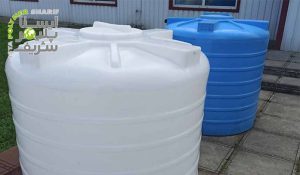The polyethylene tank factory of ABtank, with its large-scale production of polyethylene tanks, boasts one of the most professional teams in the production of polyethylene tanks. One type of storage tanks that has gained significant attention nowadays is plastic tanks, which are made from polymers such as polypropylene and polyethylene. However, polyethylene is more commonly used. By leveraging polymer science and industrial machinery, water storage tanks can be produced with precision and minimal error. The production of a plastic object is achieved through molding. Today, the polyethylene tank factory has greatly advanced with technical expertise in this field. The production of polyethylene tanks is considerably easier and faster compared to metal tanks.
Steps in Manufacturing Polyethylene Tanks at the Factory
Some of the plastic injection and molding methods include blow molding and rotational molding. In a polyethylene tank factory, the mold shape and dimensions are designed. For producing a polyethylene tank, rotational (or spinning) molding is used due to the desired hollow structure. In this method, polyethylene granules are placed inside the designed mold. In fact, this powder or polymer granules are placed in the cold mold, and the mold is then closed.
After heating and uniform heat transfer throughout the mold with biaxial rotation, the polymer material takes the shape of the mold once it heats up. Cooling is then performed until the plastic tank separates from the metal mold. The biaxial rotation continues until the plastic cools. Producing a water tank using this method results in a seamless tank. Manufacturing polyethylene tanks and setting up the factory is very cost-effective.
Advantages of Rotational Molding
The advantages of rotational molding include:
- Production of large, hollow, symmetrical parts with no seams or hinges
- No need for multiple molds
- No need for pressure during the process, thus reducing costs
- Uniform thickness of produced parts
- Absence of internal stresses
- Significantly less waste compared to other molding methods
Weight of Polyethylene Tanks
The weight of polyethylene tanks depends on the density of polyethylene granules. Polyethylene comes in several grades. From lightweight to heavy polyethylene, each has specific molecular weight and density, increasing from light to heavy. The grades of polyethylene include LDPE, LLDPE, MDPE, HDPE, and UHMWPE.
Heavy polyethylene provides better properties to the manufactured tank but melts more slowly compared to light polyethylene. However, the lightest tanks among concrete, metal, galvanized, and plastic tanks are polyethylene and plastic tanks, which have a lower weight compared to other tanks. Polypropylene plastic tanks are also produced; the lower the molecular weight, the lower the melt flow index, and the tank is produced in a shorter time at the polyethylene tank factory.
However, very low molecular weight does not provide desirable properties. On the other hand, if multi-layer polyethylene tanks are produced, they are heavier than single-layer tanks but offer better properties against factors such as ultraviolet light. Foam-filled polyethylene tanks also increase weight, which can be advantageous in extremely cold and hot environments to prevent heat transfer.






